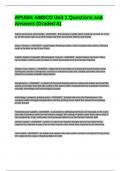Exam (elaborations)
APUSH: AMSCO Unit 1 Questions and Answers (Graded A)
- Course
- Institution
APUSH: AMSCO Unit 1 Questions and Answers (Graded A)APUSH: AMSCO Unit 1 Questions and Answers (Graded A)APUSH: AMSCO Unit 1 Questions and Answers (Graded A)APUSH: AMSCO Unit 1 Questions and Answers (Graded A) Native Americans; land bridge - ANSWER - first people to settle North America; arrived as...
[Show more]



